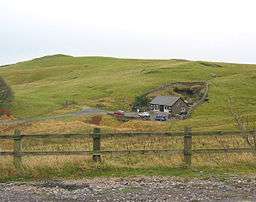Blue John Cavern
| Blue John Cavern | |
|---|---|
|
Entrance to the Blue John cavern | |
| Location | Castleton, Derbyshire |
| Geology | Blue John |
| Entrances | 1 |
The Blue John Cavern is one of the four show caves in Castleton, Derbyshire, England. The cavern takes its name from the semi-precious mineral Blue John, which is still mined in small amounts outside the tourist season and made locally into jewellery. The deposit itself is about 250 million years old.
The miners who work the remaining seams are also the guides for underground public tours. The eight working seams are known as Twelve Vein, Old Dining Room, Bull Beef, New Dining Room, Five Vein, Organ Room, New Cavern and Landscape.
In 1865, Blue John Cavern was the site of the first use of magnesium to light a photograph underground. It was taken by Manchester photographer Alfred Brothers.[1]
Blue John

In the UK Blue John, or "Derbyshire Spar", is found only in Blue John Cavern and the nearby Treak Cliff Cavern. It is a type of banded fluorite. The most common explanation for the name is that it derives from the French bleu-jaune, meaning 'blue-yellow', but other derivations have been suggested.[2]
In popular media
The cavern was featured on the 2005 TV programme Seven Natural Wonders as one of the wonders of the Midlands.
In the 2010 series of How it's Made, the cave and jewellery production of Blue John was featured.
Blue John Cavern is also visited by a couple in the 2013 film Sightseers.
References
- ↑ Chris Howes (1989-12-23). "Art of Darkness". New Scientist. Retrieved 2014-07-05.
- ↑ George, Ken (2009). An Gerlyver Meur: Cornish-English, English-Cornish Dictionary. Cornish Language Board. ISBN 1-902917-84-7.
External links
Coordinates: 53°20′44″N 1°48′13″W / 53.3456°N 1.8035°W

